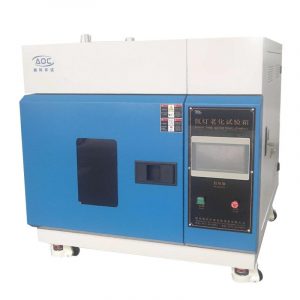Application of xenon lamp aging test chamber to gas arc exposure of degradable plastics
Degradable plastic is a kind of plastic that can be decomposed in the natural environment and has degradation properties, which can effectively reduce the pollution to the environment. However, degradable plastics can be affected by ultraviolet light, high temperature, high humidity and other factors during long-term use and exposure to the natural environment, leading to their aging and rupture. Therefore, it is necessary to test and evaluate the aging resistance of degradable plastics. Xenon lamp aging test chamber can simulate the durability of degradable plastics in different climatic conditions to evaluate their aging resistance.

In the application of degradable plastics, xenon lamp aging test chamber can simulate the ultraviolet radiation, high temperature, high humidity and other factors of degradable plastics in actual use to simulate their aging process in actual use. By regularly observing and measuring the appearance, mechanical properties and other indicators of degradable plastics, their durability and aging resistance can be evaluated, so as to predict their performance and life in actual use.
Application of xenon lamp aging test chamber to gas arc exposure of degradable plastics
In addition, xenon lamp aging test chamber can also carry out other related tests, such as degradation rate of degradable plastics, biodegradation performance and other performance tests. By comprehensively evaluating these performance indicators, the performance and life span of degradable plastics in practical use can be evaluated, and their quality and reliability can be improved to provide better protection and decorative effects for applications in various fields.
When testing xenon lamp aging test chamber, it is necessary to pay attention to the selection of appropriate test conditions, sample preparation, result interpretation and other issues to ensure the accuracy and reliability of test results. At the same time, it is also necessary to pay attention to the maintenance and maintenance of test equipment to ensure its stability and accuracy.
In addition to the application area of degradable plastics, xenon arc aging chambers can also play a role in the testing and evaluation of other plastic materials. For example, it is possible to evaluate the durability and aging resistance of plastic materials such as polyethylene and polyvinyl chloride under different environmental conditions. By simulating different environmental conditions, it is possible to evaluate the performance and lifetime of materials, thereby improving product quality and reliability.
Application of xenon lamp aging test chamber to gas arc exposure of degradable plastics
Notes
When testing xenon lamp aging chamber, the following points should be paid attention to:
Select the appropriate test conditions: according to the material tested and the actual use environment, select the appropriate test conditions, including the type of light source, irradiation intensity, temperature, humidity, etc.
Sample preparation: Different sample preparation methods should be used for different materials, such as environment-friendly solvents for sample preparation for degradable plastics, to avoid affecting the test results.
Interpretation and analysis of results: After the test is completed, the test results need to be interpreted and analyzed to assess the performance and life of the material, and the test results need to be recorded and reported.
Xenon lamp aging test chambers are widely used in the testing and evaluation of materials and products in various fields. By simulating different environmental conditions, it is possible to evaluate the performance and lifetime of materials and products, thereby improving product quality and reliability. When conducting the test, attention should be paid to the selection of appropriate test conditions, sample preparation, result interpretation and other issues to ensure the accuracy and reliability of the test results.
